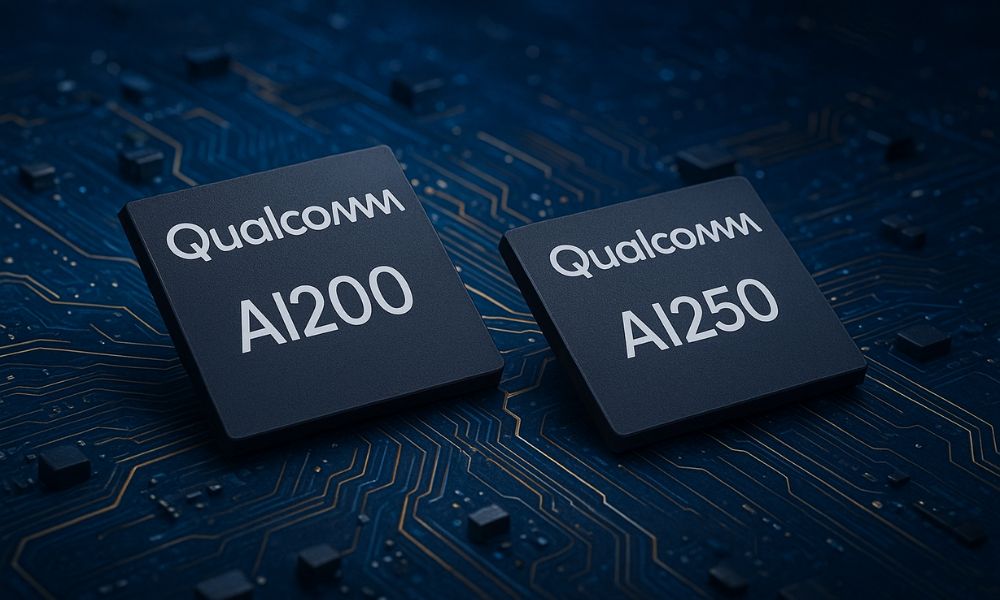Qualcomm, a global leader in mobile and edge compute technologies, has officially revealed its latest breakthrough — the AI200 and AI250 chips, the next generation of AI-focused processors designed to power the future of smart devices, robotics, and IoT systems.
These chips serve as a substantial evolution in AI acceleration, energy efficiency, and edge intelligence, delivering quicker neural processing while consuming significantly less power. Qualcomm aims to expand on-device AI with the AI200 and AI250 chips across a variety of product offerings — from industrial machines and surveillance systems to next-generation smartphones and smart home devices.
Let us dive into how the new AI chips raise the bar on intelligent computing for 2025 and beyond.
The Evolution of Qualcomm’s AI Chips
The AI chip family of Qualcomm has been developed continuously over the last several years, no longer focusing on the conventional CPU and GPU performance but on specialized AI engines, which can process data in real-time at device level.
The successors of the Qualcomm AI100 and AI150 lines are the new AI200 and AI250, and these are used in edge AI systems like autonomous systems, retail analytics and industry automation.
These enhancements mark another move towards decentralizing AI by Qualcomm, which moves the capability of big models directly on the phones without dependence on cloud-based computing. This change increases speed, privacy and responsiveness.
AI200 and AI250: Intelligent Efficiency
- The two chips, AI200, and AI250, are both based on the advanced 4nm architecture of Qualcomm that allows it to balance both the processing power and energy efficiency.
- The AI200 is focused on low-power and small-sized AI designs, so it is suited to consumer goods, smart cameras, and IoT products.
- The AI250 in contrast is geared towards high-performance edge computing such as robotics, industrial AI, and real-time analytics.
They combine to create an elastic platform that enables the device manufacturers to select the optimal balance between power and efficiency to their individual applications.
Important Features and Capabilities
Improved Neural Processing Units (NPUs):
Both of these chips will include Qualcomms 6 th generation AI Engine with upgraded NPUs, and have the ability to provide up to 50 TOPS (Tera Operations Per Second) of AI compute power.
Supporting on-Device Large Language Models (LLM):
Qualcomm has tailored the chips to support AI models and billions of parameters that can be run on the device, avoiding reliance on cloud computing.
Superior Energy Efficiency:
The AI200 and AI250, based on a 4nm process, are 40 percent more performance-per-watt efficient than earlier models, with a longer battery life and lower heat.
Multi-Sensor Fusion:
These chips combine visual, audio and contextual information processing all together – supporting high-level capabilities such as object recognition, voice support and predictive analytics.
5G and Edge Connectivity:
Specifically, the AI250 supports 5G sub-6GHz and mmWave connectivity that will facilitate real-time exchange of data between smart systems and edge servers.
Scalability and Modularity:
The platform can be configured to support all types of wearables, all the way to the full-scale AI-enabled surveillance cameras and industrial robots.
Developer and Consumer Advantages
For Developers:
- Easy access to the Qualcomm AI Stack SDK with support to all the popular frameworks, such as TensorFlow and PyTorch.
- Quantization and model optimization tools e.g. Enable effective execution of complex AI models with limited hardware.
- Cross-platform scalability – the same code can be used on AI200 or AI250, or even on other systems based on the performance requirements.
For Consumers:
- An AI-based application can respond faster to voice recognition, image processing, and navigation.
- Increased privacy and security, because sensitive data will not be transferred to the cloud but will be processed locally.
- Longer battery life, even with sustained AI workloads.
Use Cases of Qualcomm AI200 & AI250 Chips
| Application Area | AI200 Use Case | AI250 Use Case |
|---|---|---|
| Smart Cameras | Real-time object detection, facial recognition | High-definition video analytics, edge AI surveillance |
| IoT Devices | Smart speakers, home automation | Industrial IoT control systems, logistics management |
| Robotics | Lightweight consumer robots | Autonomous industrial and delivery robots |
| Automotive | In-cabin driver monitoring | ADAS (Advanced Driver Assistance Systems) |
| Healthcare | Wearable health sensors | Medical imaging and diagnostics |
| Retail & Analytics | Smart shelves and digital signage | Large-scale customer behavior analytics |
Technical Specifications
| Feature | Qualcomm AI200 | Qualcomm AI250 |
|---|---|---|
| Architecture | 4nm AI-optimized SoC | 4nm AI-optimized SoC |
| AI Compute Power | Up to 25 TOPS | Up to 50 TOPS |
| CPU Configuration | Octa-core Cortex-A7x | Octa-core Cortex-X series |
| GPU | Adreno AI Lite | Adreno AI Pro |
| Memory Support | LPDDR5 up to 16GB | LPDDR5x up to 32GB |
| Connectivity | Wi-Fi 6, Bluetooth 5.3 | Wi-Fi 7, 5G (mmWave/Sub-6GHz), Bluetooth 5.4 |
| Thermal Design Power (TDP) | 8W typical | 15W typical |
| AI Framework Support | TensorFlow Lite, PyTorch Mobile | TensorFlow, PyTorch, ONNX |
| Security | Qualcomm Secure Processing Unit (SPU) | Advanced SPU with Hardware AI Guard |
| Target Devices | Smart cameras, IoT, wearables | Robotics, edge servers, industrial AI |
Why the AI200 and AI250 Matter
The introduction of the AI200 and AI250 chips highlight the efforts that Qualcomm is putting into making devices smart. With an increase in the resource-intensity of the AI applications, it is essential to push the computation to the edge to ensure that speed, privacy, and efficiency are not compromised.
Qualcomm is building a brand as more than a mobile chip leader with these new processors but an AI-driven infrastructure. It can be self-educating drones, intelligent factories, intelligent surveillance systems, the AI200 and AI250 are supposed to take AI everywhere, but faster and more safely.
Conclusion
The Qualcomm AI200 and AI250 chips are the uppermost advancement in the field of AI. These chips will drive the future generation of AI-powered devices through industries with intelligent processing, high efficiency, and scalable deployment services.
By 2025, with these processors built into virtually everything, including industrial robots and luxury smartphones, you will witness the beginning of an entirely AI-driven ecosystem, one in which smartness occurs in real time, in real places, and in real security.
FAQ
1. What is an AI200/AI250 chip of Qualcomm?
The next-generation AI-centric processors, the Qualcomm AI200 and AI250, are made to run on-device intelligence with high performance. They are programmed to run AI-based systems like robots, Internet of Things, intelligent cameras, and edge servers. Both the chips have high-performance neural processing units (NPUs) that provide quick, effective, and safe AI computing devoid of cloud computing.
2. What is the difference between AI200 and AI250?
The AI200 targets low power uses, like consumer electronics, smart cameras and IoT devices, and the AI250 is targeted at high performance edge computing, suitable in robotics, industrial AI and large scale analytics. The AI250 provides an increased compute (up to 50 TOPS) and connectivity (5G and Wi-Fi 7).
3. What are the key advantages of these new Qualcomm AI chips?
The AI200 and AI250 have a number of positive features:
- The AI can infer and model execution is faster.
- The 4nm process has led to better power efficiency.
- On device support of large AI models.
- Local processing to improve privacy and data security.
- Better developer support using Qualcomm AI Stack SDK.
They are well suited to real-time use, such as smart cities, automation in industry, and autonomous systems, because of such benefits.
4. What industries or devices will AI200 and AI 250 be most useful?
The AI200 and AI250 chips are aimed to improve a large variety of industries:
- Smart gadgets such as cameras, wearables and home automation items.
- Industrial, delivery and service automation robotics.
- ADAS and driver monitoring automotive systems.
- Medical equipment of smart diagnostics and control.
- Customer behavior and real time data analytics and retail.
These chips are a big step to smart connected ecosystems in industries.
5. What is the performance of Qualcomm AI200 and AI250 chip in on-device AI relative to cloud-computing?
The AI200 and AI250 are created to deliver the AI processing to the devices without the necessity of always having to use cloud servers. This offers several advantages to it; it has a faster response time, lesser latency, increased privacy and reduced costs of data transmission.
The machines are capable of running image recognition as well as speech processing and predictive analytics without an internet connection by running large AI models on the device itself. This not only increases the performance, but also ensures reliability and security of the devices in real time applications.



